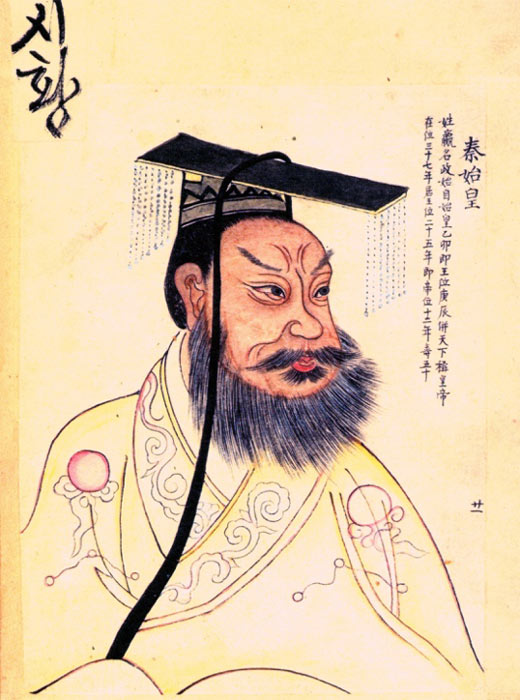
Cosmic Rays Could Finally Reveal Structure of Mysterious Tomb of China’s First Emperor
For over two millennia, the tomb of China’s first emperor, Qin Shi Huang have been locked away, with scientists and historians the world over desperate to catch a glimpse of what really lies within. The mausoleum, now a UNESCO World Heritage Site located in the Xi’an Lintong District, was accidentally unearthed by a group of peasants back in 1974. But it is only now that the development of science allows us an opportunity to understand Qin Shi Huang’s mysterious reign. Scientists plan to use cosmic rays to scan the sealed tomb of the Chinese first emperor, who was buried with the famous miniature Terracotta Army, whose purpose was to protect him in the afterlife.

Scientists have been searching for non-invasive methods of finding out more about the tomb of China’s first emperor, Qin Shi Huang. (Public domain)
Qin Shi Huang - The Chinese First Emperor’s Tomb and His Terracotta Army
The Terracotta Army lies to the east of the Chinese first emperor’s tomb. Numbering thousands, it is believed to have been positioned there so as to protect the first unifier of China from his eastward expansion and rule, which ended in 210 BC (the Qin had conquered all of the Warring States and unified China in 221 BC).
For more than 2,000 years, the emperor’s secrets lay hidden underground, guarded by his Terracotta Army. Experts believe that the Terracotta Army was once painted, but immediately lost its color when the initial discovery was made and the tomb was exposed to the atmosphere, but also faced the brunt of nature, buried beneath layers and layers of vegetation.
- The Secret Tomb of the First Chinese Emperor Remains an Unopened Treasure
- 220 More Terracotta Warriors Found in Chinese Emperor’s Tomb
For the few decades since its discovery, Chinese authorities have been reluctant to allow the opening of the Chinese first emperor’s tomb, even for inspection purposes, fearing an absence of appropriate preservation techniques, reports The Daily Mail. The massive burial site located in the northwest city of Xi’an, is nearly 70 times the size of the Forbidden City in terms of area. It took almost four decades and hundreds of thousands of laborers to complete, but has never been fully excavated. That could be about to change.
The first emperor of China was obsessed with his mortality and wanted to create an elixir that would grant him immortality, and the power to live through 10,000 generations of his dynasty. This is as per 36,000 wooden strips with intricate calligraphy, that revealed that the posthumous Terracotta Army was an extension of Qin Shi’s desire to rule even in his afterlife, reveals a Smithsonian report from 2017.

The excavations and restoration of the Terracotta Army has been a challenge. Originally painted, the sculptures lost their color when exposed to the atmosphere. This kind of damage is the reason for why China has as yet not excavated the first emperor’s tomb. (Gary Todd / CC0)
Muon Scanning Technology and its Benefits
Now, scientists are proposing the use of subatomic particles called muon to map out the interior of the subterranean inner chamber. Muons are absorbed by thick, dense objects, but can pass through lighter materials. These muon detectors are used by archaeologists to map out structures, look for buried sites, and have been known to work in tough terrain like volcanoes, caves, and pyramids, as noted by The Times. This approach was used in 2017, to reveal a 98-foot-long (29.8 m) chamber within the Great Pyramid at Giza.
The idea to use this technology to reveal hereto unknown information about the Chinese first emperor’s tomb was proposed by physicist Yuanyuan Liu of the Beijing Normal University and her colleagues. The team normally uses cosmic rays to investigate dark matter at the China Jinping Underground Laboratory, the best shielded underground laboratory in the world, and the world’s deepest located cosmic ray facility, located 3.7 miles (5.9 km) under the Sichuan province.
“As an ancient civilization with a long history, China has a large number of cultural relics that are in need of archaeological research,” highlighted the team from Beijing Normal University, who explained that traditional non-intrusive methods have limitations.

Site plan of the Chinese first emperor’s tomb, which shows the location of the tomb in comparison to the Terracotta Army to the east. (Martinón-Torres et al / Journal of Archaeological Method and Theory)
“The application of muon absorption imaging to the archaeological field can be an important supplement to traditional geophysical methods. Preliminary imaging results prove the feasibility of muon absorption imaging for the underground chamber of the mausoleum of the first Qin emperor,” stressed the Beijing Normal University scientists.
- The Ruthless Chinese Emperor Qin Shi Huang: How He Unified and Tyrannized His Subjects
- How the Search for Immortality Killed the First Emperor of China
Experts believe that the subterranean chambers are still intact. Archaeologists find the possibility of grave robbers having tunneled into the Chinese first emperor’s tomb unlikely, both because there is no evidence of the same and because the possibilities of anyone reaching this deep remain improbable. Their most recent finds have been published in the Acta Physica Sinica journal.
But, since muon is a slow technology, muon detectors would need to be in place for at least a year before being able to create any meaningful imagery of the structure of the first emperor’s ancient tomb. Therefore, the results of this technology and what it could reveal about the Chinese first emperor’s tomb are awaited with baited breath.
Top image: The Chinese first emperor’s tomb was protected by the famed Terracotta Warriors. Source: Carlos Adampol Galindo / CC BY-SA 2.0
By Sahir Pandey















